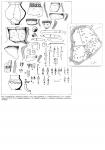Summary (English)
The Western Bilsk hillfort is situated on a plateau between the Vorskla and Sukha Grun rivers, on the high banks of the latter. Its modern surface is covered with ash hills that could be seen as kurgan-like mounds with slightly lighter soil. Archaeological excavation of ash hill 5 has been carried out since 1998. In the year 2004, two excavation sites were dug out in its periphery.
The southern excavation site measured 64 m2. The stratigraphy of the ash hill is the following: up to 30 cm – ploughing layer; 30-80 cm – cultural layer; 80-120 cm – clear black soil; below 120 cm – yellow clay. Four household pits were explored here; they were filled with ashy soil containing pieces of charcoal, pottery and animal bones.
Pit 23 was distinguished by a find of a large storage jar and a fragment of a late 6th – early 5th c. BC Chios amphora. Besides that, a pin and an arrowhead date by the 5th c. BC was found here.
Pit 25 was filled with burnt clay and stones, as well as fragments of pottery that probably were dumped from a hearth. An unusual handmade pot with two handles could be considered as a copy of a Greek amphora. Fragments of a Samos and Klazomenai amphorae from this pit date by the second half of the 6th c. BC.The western excavation site measured 57 m2. The stratigraphy of the ash hill is the following: up to 35 cm – ploughing layer; 35-90 cm – cultural layer filled with a large amount of ash. Two household pits were explored here. The sacrifice of a goat and a bear skull was found in one of them (No 26). Black-glazed handmade pottery could be seen at this part of ash hill. However, Greek amphorae fragments belong to the 6th c. BC.
Numerous artefacts were obtained from the cultural layer. Typical decoration of the pot’s rims are pricks and raised punctured borders. Storage jars and ladles are present in smaller amounts. Among the bone finds, one should mention tools for leather currying, pipes and polisher. Greek vessels are also present in the layer: fragments of Chios, Thasos, Lesbos and Klazomenai amphorae and a black-glazed kylix of the late 6th – early 5th c. BC. Metal artefacts are numerous and point to diversified crafts in the life of the local population. One can mention a hand drill, different types of knives, a needle, an awl, plates for a scale armour, pieces of a horse bridle, a fragment of a bronze cauldron and drops of bronze. Notable adornments are the pins and boar fang pendant.
- Shelekhan Oleksandr - Institute of Archaeology, National Academy of Sciences of Ukraine
Director
- Iryna Shramko - V.N. Karazin Kharkiv National University
- Stanislav Zadnikov - V.N. Karazin Kharkiv National University
Team
- Vladislav Bondarenko - V.N. Karazin Kharkiv National University, Museum of Archeology and Ethnography of Slobidska Ukraine
Research Body
- ДП «Слобідська археологічна служба» ОАСУ Інституту археології НАН України / State enterprise «Slobidska archeological service» of the state enterprise «Protection of the archeological survey of Ukraine» of the Institute of Archeology of the National Academy of Sciences of Ukraine
- Музей археології і етнографії Слобідської України Харківського національного університету ім. В.Н. Каразіна / Museum of archeology and ethnography of Slobidska Ukraine, V. N. Karazin Kharkiv National University






![Download [PDF]](/excavation/skins/fasti/images/results/download_sml.png)